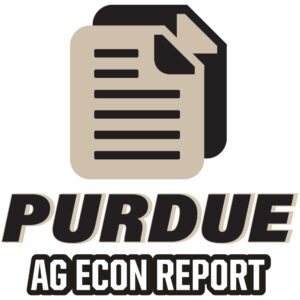Hog Production Losses Continue
December 12, 2016
PAER-2016-17
Chris Hurt, Professor of Agricultural Economics
For 2016 live hog prices are going to average about $46 per live hundredweight which is down from around $50 in 2015. They are expected to be higher in 2017, around $47.
Hog prices in the final quarter of 2016 will average about $37 per hundredweight representing the lowest fourth quarter price since 2002. Prices have been depressed since the third quarter of 2016 and have dropped more sharply than expected.
Pork production in 2016 was about 2% greater than the year before, but with exports up over 3% and imports down, the actual amount of pork available to consumers was actually down. This would have suggested stronger prices, not weaker.
The culprit appears to be a shortage of processing capacity in the last quarter of 2016. It is generally thought that 2.5 million head per week is near federal inspection capacity. In four of the past seven weeks, the number of head processed at federal inspected plants has been above 2.5 million head.
When there is a shortage of capacity in any industry there tends to be high returns to those who own that capacity. That seems to be the case this fall as the farm-to-wholesale margin is at record high levels. Looking at the most recent data, the farm-to-wholesale margin for January through October has averaged 68 cents per retail pound this year compared to 56 cents per retail pound for the same period in 2015, (USDA).
If all of this higher margin were bid into the farm level price it would increase live hog prices by $5 to $7 per live hundredweight.
After averaging about $37 for the final quarter of 2016, prices are expected to improve to about $43 for the first quarter of 2017 with head counts that are a little smaller. Then, seasonally smaller supplies in the second and third quarter could support live hog prices in the low $50s.
Two new processing plants are expected to come on-line by the fall of 2017 and these should relieve the capacity shortage and allow hog prices to be higher a year from now, even though hog supplies will be higher. Current forecast are for live hog prices to average about $44 in the fourth quarter of 2017.
With current costs estimated at $49, this means large losses for the current quarter of about $34 per head. First quarter 2017 losses would drop to $18 per head. Small profits of about $5 a head are expected for the spring and summer, but returning to losses of around $16 in the final quarter.
My estimates of annual losses of about $11 per head in 2016 are expected to drop to $6 a head in 2017. More packer capacity will help hog prices in 2017. In addition, retail pork prices are expected to continue to drop and provide stronger domestic usage, and pork exports are expected to grow in 2017 as well.
Nevertheless, these positive factors will not be enough to bring the industry back to the breakeven level. Therefore, the industry will need to consider a reduction in the breeding herd in the last half of 2017 in order to boost prices back closer to breakevens in 2018.
